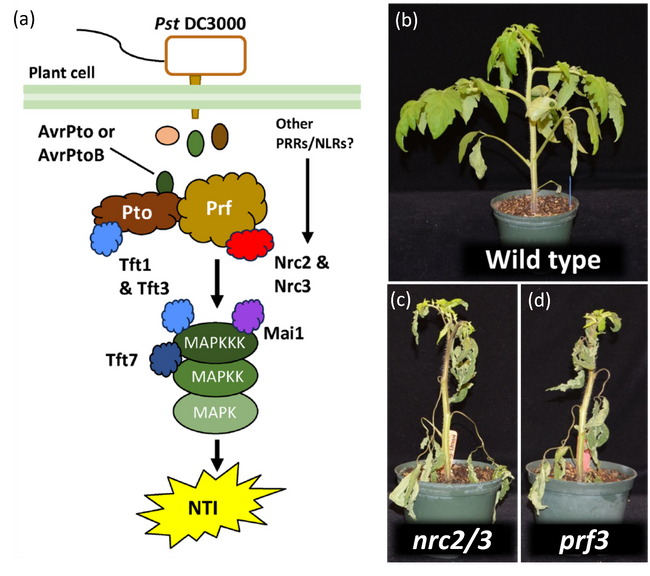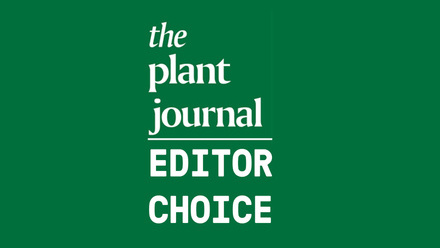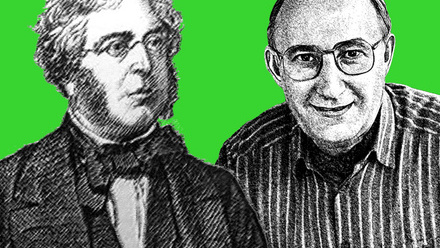December 2023 TPJ Editor choice: Bolstering the defence line: the vital role of helper NLRs in tomato disease resistance
Highlighted publication:
Helper NLRs Nrc2 and Nrc3 act codependently with Prf/Pto and activate MAPK signaling to induce immunity in tomato. https://doi.org/10.1111/tpj.16502
Bolstering the defence line: the vital role of helper NLRs in tomato disease resistance
The evolutionary arms race between plants and pathogens has given rise to a wide diversity of plant receptor proteins that detect pathogen-derived compounds and elicit processes to counteract infection. Nucleotide-binding leucine-rich repeat proteins (NLRs) are a vital component of the plant immune system; they recognise pathogen effector molecules and subsequently trigger responses collectively referred to as NLR-triggered immunity or effector-triggered immunity. These responses include expression of defence genes, generation of reactive oxygen species and, ultimately, programmed cell death thought to confine pathogen spread within the plant.
One of the best-studied NLR cascades involves the tomato NLR Prf and its interacting serine/threonine kinase Pto. The Prf/Pto complex binds effectors translocated into the plant cell by the bacterial pathogen Pseudomonas syringae pv. tomato (Pst), the causal agent of bacterial speck disease, and subsequently activates a mitogen-activated protein kinase (MAPK) cascade to trigger programmed cell death and promote disease resistance. Prf/Pto act together with multiple sets of proteins to coordinate immune responses (Fig. 1a): (1) the 14-3-3 proteins Tft1, Tft3 and Tft7 interact with Prf/Pto as well as members of the MAPK cascade and promote Prf/Pto-mediated programmed cell death; (2) the receptor-like kinase Mai1 acts upstream of the MAPK cascade to accelerate programmed cell death; and (3) the NLRs required for cell death 2 (Nrc2) and Nrc3 interact with Prf. These Nrc proteins act as helper NLRs, i.e., they contribute to immunity but are not involved in effector recognition.
Zhang and colleagues set out to further examine the importance of helper NLRs in tomato immune responses by generating nrc CRISPR loss-of-function mutants. All nrc mutants were morphologically indistinguishable from wild type under control conditions, but it was a different story when these plants were challenged with the Pst pathogen: the nrc2 nrc3 double mutant displayed increased susceptibility to Pst, to the same level as a prf mutant (Fig. 1b-d), and even the nrc3 single mutant displayed more pronounced disease symptoms and supported a heavier bacterial load than wild type. The authors observed no differences in susceptibility when plants were challenged with Pst strains lacking the effectors recognised by the Prf/Pto module, nor when they were exposed to flagellin-derived molecules that trigger different immune signalling cascades. Thus, Nrc2 and Nrc3 have both additive and redundant functions in Prf/Pto-mediated immunity, with Nrc3 likely playing a more prominent role.
To pinpoint where the two helper NLRs act in the Prf/Pto signalling cascade, Zhang et al. performed epistasis analyses between the nrc mutants and lines expressing autoactive variants of Prf/Pto signalling components. While autoactive versions of Prf and Pto triggered programmed cell death in a wild-type background, this cell death phenotype was absent when the proteins were expressed in a nrc2 nrc3 background. In contrast, constitutively active variants of M3Kα and Mkk2, which act in the MAPK cascade downstream of Prf and Pto, elicited a cell death phenotype regardless of whether they were expressed in the wild-type or nrc2 nrc3 mutant backgrounds. In line with these findings, Pst infection caused increased MAPK activity in the wild type while this effect was completely abolished in both nrc2 nrc3 and prf mutants. Taken together, these results suggest that Nrc2 and Nrc3 act codependently with Prf and Pto, upstream of the MAPK cascade, to promote NLR-triggered immunity (Fig. 1a).
The findings by Zhang et al. highlight the important role Nrc2 and Nrc3 play in plant immunity. Helper NLRs, such as Nrc2 and Nrc3, represent promising targets for enhancing disease resistance through breeding or gene editing approaches, but a thorough understanding of the signalling mechanisms involved is essential before such genes can be harnessed to improve crop resilience in the future.




